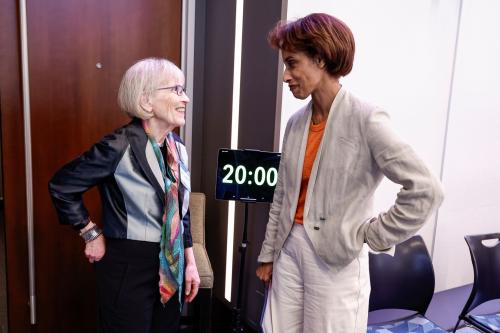This report was produced as part of the January 24, 2019, event Improving opportunities for those who want to work longer.
Older people need to work longer in order to ensure a secure retirement. Social Security, the backbone of the retirement system, will not replace as much preretirement income in the future as it does today. Employer-sponsored retirement plans also involve considerably more uncertainty, given the shift from defined benefit plans to 401(k) plans. With these institutional saving arrangements on the decline, people could decide to save more on their own. But personal saving outside employer plans is virtually nonexistent, with the exception of home equity—an asset that retirees are reluctant to tap. Combine the retirement income crunch with the dramatic increase in life expectancy and growing health care costs, and continued employment in later life is the best option for ensuring financial security. The challenge is to ensure that older Americans plan to keep working and that employers retain and hire them.
Any policy options need to be calibrated to the nature of the problem. Keeping older people in the labor force requires more than bringing the matter to the public’s attention. Many are already getting the message; the share of people planning to work past age 65 has tripled over the past three decades, from 16 to 48 percent.1 However, such intentions often go awry, as nearly two in five workers end up retiring earlier than planned.2 The reasons for premature retirement involve a variety of factors that affect the choices made by both employees and employers.
On the employee side, one disincentive to continued work is a high implicit tax on earnings due to Social Security and Medicare provisions.3 Another issue is a lack of knowledge about Social Security’s financial gain for delaying claiming until age 70, when monthly benefits are at their peak. In addition, workers with 401(k) plans approaching retirement may think that a typical asset balance of $100,000 for an individual is sufficient, failing to realize that it translates into only a modest supplement to retirement income.
On the employer side, one barrier to hiring and retaining older workers is the uncertainty about how long they will stay on the job and concern that their productivity may outweigh their costs well before they plan to retire. This uncertainty may lead employers to circumvent rules against age discrimination in hiring by devising policies that have the effect of shedding older workers. A more subtle barrier is the general misperceptions employers may have about older workers’ abilities.
In “Proposals to Keep Older People in the Labor Force” (PDF), Alicia H. Munnell and Abigail N. Walters discuss proposals to help keep older workers in the labor force. These proposals include addressing employees by changing the financial incentives to work through expanding the Earned Income Tax Credit (EITC) for individuals without dependent children as well as exploring three ways to help people make better-informed work and retirement decisions:
- establishing that age 70 is the national retirement age;
- restating 401(k) balances as flows of retirement income; and
- instituting workplace seminars for employees in their 50s about the advantages of working longer.
The authors also propose ways employers can help keep older workers in the labor force by reintroducing mandatory retirement in the expectation that employers would be more willing to retain or take on older workers if they could dismiss them at 70; and undertaking a massive public education campaign to make the business case for older workers.
The authors conclude that ultimately more research is needed to understand the problems and potential solutions. “We already know what needs to be done. The next step is to convince policymakers to actively and energetically support these types of initiatives. The payoff from success will be enormous: transforming the workforce, the economy, and the culture in a way that will ensure retirement security for today’s workers and future generations.”
Read the full report here.
Alicia H. Munnell is the director of the Center for Retirement Research at Boston College and the Peter F. Drucker Professor of Management Sciences at Boston College’s Carroll School of Management. She is a council member of the Governor’s Council to Address Aging in Massachusetts. She is a member of the Pension Research Council and a board member of the Pension Rights Center, the National Bureau of Economic Research and The Century Foundation.
Abigail N. Walters is a research associate at the Center for Retirement Research at Boston College and a staff member of the Employment Workgroup of the Governor’s Council to Address Aging in Massachusetts.
Other than the aforementioned, the authors are currently not an officer, director, or board member of any organization with an interest in this article.
Munnell has received grants from the Prudential Insurance Company and the Social Security Administration related to past research.
Other than the aforementioned, the authors did not receive any financial support from any firm or person for this article or from any firm or person with a financial or political interest in this article.
-
Footnotes
- Employee Benefit Research Institute (2018).
- Authors’ calculations from the Health and Retirement Study.
- Once an individual has 35 years of work history, Social Security benefits from additional years of work rise more slowly than earnings and taxes. And Medicare’s secondary payer provision requires employer-sponsored health insurance to continue to be the primary payer for workers age 65 and over. See Goda, Shoven, and Slavov (2018).



